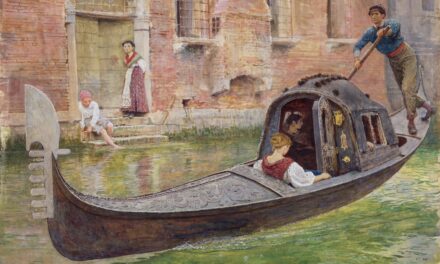The life of Gian Lorenzo Bernini, one of the most celebrated artists of the Baroque period, began in Naples in 1598. Born into a family of artists, Bernini was exposed to the world of art from a very young age. His father, Pietro Bernini, was a sculptor who played a pivotal role in shaping Gian Lorenzo’s early artistic sensibilities.
The family moved to Rome when Gian Lorenzo was just eight years old, a city that would become the backdrop for his illustrious career. In Rome, he was immersed in the vibrant artistic culture of the time, surrounded by the works of masters such as Michelangelo and Caravaggio. This environment not only nurtured his innate talent but also instilled in him a deep appreciation for the classical traditions that would later inform his own work.
Bernini’s formal education in art was somewhat unconventional. He did not attend a traditional art school; instead, he learned through direct experience and observation. His early works, created under the guidance of his father, showcased his prodigious talent and quickly garnered attention.
By the age of 17, he had already completed his first major commission, a bust of Pope Paul
Summary
- Sir Christopher Wren was born in East Knoyle, Wiltshire, England in 1632 and was educated at the University of Oxford.
- Wren was heavily influenced by the works of Italian architects and the classical style, which is evident in his designs such as St Paul’s Cathedral.
- His major works include the Royal Hospital Chelsea, Greenwich Hospital, and the rebuilding of 52 churches after the Great Fire of London.
- The Barberini Ceiling in the Palazzo Barberini in Rome is one of Wren’s most famous works, showcasing his skill in decorative and architectural design.
- Wren’s architectural contributions include advancements in structural engineering, such as the use of timber trusses and the development of the hipped roof.
Influences and Style
Bernini’s artistic style is often described as a synthesis of various influences, reflecting the dynamic cultural landscape of 17th-century Rome. His work is characterised by a dramatic use of light and shadow, intricate detailing, and an ability to convey movement and emotion in stone. The influence of classical antiquity is evident in his sculptures, which often draw upon Greco-Roman themes and forms.
However, Bernini’s interpretation of these classical elements is distinctly personal; he infused them with a sense of vitality and dynamism that set him apart from his predecessors. One of the most significant influences on Bernini’s work was the Counter-Reformation, a movement within the Catholic Church that sought to reaffirm its authority in response to the Protestant Reformation. The Church commissioned numerous works from Bernini, recognising his ability to evoke spiritual fervour through art.
His sculptures often depict religious figures in moments of intense emotion, capturing the viewer’s attention and inviting them to engage with the divine. This emotive quality is particularly evident in works such as “The Ecstasy of Saint Teresa,” where Bernini masterfully conveys the saint’s mystical experience through a combination of expressive facial features and dynamic drapery. In this way, Bernini’s style not only reflects his artistic influences but also serves a greater purpose within the context of religious devotion.
Major Works and Commissions
Throughout his prolific career, Bernini produced an impressive array of works that spanned various mediums, including sculpture, architecture, and painting. Among his most notable sculptures are “Apollo and Daphne,” “The Rape of Proserpina,” and “David.” Each of these pieces showcases Bernini’s extraordinary skill in capturing human emotion and movement. “Apollo and Daphne,” for instance, depicts the moment when Daphne transforms into a laurel tree to escape Apollo’s advances, with the intricate detailing of her metamorphosis demonstrating Bernini’s mastery over marble.
In addition to his sculptural achievements, Bernini received numerous prestigious commissions that solidified his reputation as one of the leading artists of his time. His work on St. Peter’s Basilica is particularly noteworthy; he designed the grand colonnade that encircles the piazza, creating a welcoming embrace for visitors to the Vatican.
This monumental project not only exemplifies Bernini’s architectural prowess but also reflects his understanding of space and human interaction within it. His ability to harmonise sculpture and architecture is further demonstrated in the Baldachin over the high altar of St. Peter’s, where he combined elements of both disciplines to create a visually stunning focal point within the basilica.
The Barberini Ceiling
One of Bernini’s most celebrated works is the ceiling of the Palazzo Barberini, completed between 1633 and 1639. This ambitious project exemplifies his ability to merge painting and sculpture into a cohesive artistic vision. The ceiling features an elaborate fresco that depicts “The Triumph of Divine Providence,” showcasing an array of figures that seem to float above the viewer in a celestial realm.
The use of chiaroscuro creates a sense of depth and movement, drawing the eye upwards and immersing viewers in the grandeur of the scene. The Barberini Ceiling is not merely a decorative element; it serves as a testament to Bernini’s innovative approach to space and perspective. By employing techniques such as foreshortening and illusionistic architecture, he created an immersive experience that transcends traditional boundaries between two-dimensional painting and three-dimensional sculpture.
This work exemplifies Bernini’s mastery of Baroque aesthetics, where drama and emotion are heightened through visual effects. The ceiling remains a significant landmark in art history, illustrating how Bernini pushed the boundaries of artistic expression during his time.
Architectural Contributions
In addition to his sculptural achievements, Bernini made significant contributions to architecture that have left an indelible mark on Rome’s urban landscape. His design for St. Peter’s Basilica is perhaps his most famous architectural endeavour, where he played a crucial role in its transformation into one of the most iconic churches in the world.
The grand façade and impressive dome are testaments to his vision and understanding of space, light, and form. Bernini’s architectural style is characterised by its dramatic flair and theatricality, often incorporating elements that evoke emotion and grandeur. His design for the Piazza San Pietro exemplifies this approach; the colonnades create a sense of enclosure while simultaneously inviting visitors into the sacred space of St.
Peter’s Basilica. This interplay between architecture and human experience is central to Bernini’s work, as he sought to create environments that fostered spiritual reflection and connection with the divine.
Legacy and Influence
Bernini’s legacy extends far beyond his lifetime; he is often regarded as one of the most influential artists in Western art history. His innovative techniques and emotive style set new standards for sculpture and architecture during the Baroque period, inspiring generations of artists who followed in his footsteps. The impact of his work can be seen in various artistic movements that emerged after his time, including Rococo and Neoclassicism.
Moreover, Bernini’s ability to blend different artistic disciplines has had a lasting influence on contemporary art practices. His integration of sculpture with architecture paved the way for future artists to explore new ways of engaging with space and form. The emotional depth present in his works continues to resonate with audiences today, reminding us of art’s power to evoke feelings and provoke thought.
As such, Bernini remains a pivotal figure in art history whose contributions continue to be studied and celebrated.
Criticism and Controversies
Despite his immense talent and acclaim, Bernini’s career was not without its share of criticism and controversies. Some contemporaries viewed his work as overly theatrical or lacking in restraint compared to the more measured styles of earlier Renaissance artists. Critics argued that his emphasis on emotion sometimes overshadowed technical precision, leading to debates about what constituted true artistry during this period.
Additionally, Bernini’s close relationship with powerful patrons, particularly within the Catholic Church, raised questions about artistic independence versus servitude to authority. Some critics contended that his works were overly influenced by ecclesiastical demands rather than personal expression. These controversies highlight the complex dynamics between art, power, and individual creativity during the Baroque era.
Recognition and Honors
Throughout his life, Bernini received numerous accolades for his contributions to art and architecture. He was appointed as the official architect for St. Peter’s Basilica by Pope Urban VIII, solidifying his status as one of the leading figures in Baroque art.
His works were celebrated not only for their technical mastery but also for their ability to convey profound spiritual messages. In recognition of his achievements, Bernini was awarded various honours during his lifetime, including noble titles and commissions from influential patrons across Europe. His legacy continues to be honoured today through exhibitions dedicated to his work and scholarly research exploring his impact on art history.
Museums around the world house collections featuring Bernini’s masterpieces, ensuring that future generations can appreciate the brilliance of this extraordinary artist who forever changed the landscape of Western art.
For those interested in learning more about the techniques used by artists like Pietro da Cortona, a helpful article on Think of Art explores the use of layered colour glazes to build depth in transparent layers. The article discusses how artists can achieve a sense of depth and richness in their work by carefully layering colours to create a sense of luminosity and complexity. To read more about this fascinating technique, visit here.
FAQs
Who was Pietro da Cortona?
Pietro da Cortona was an Italian Baroque painter and architect. He was born Pietro Berrettini in Cortona, Italy in 1596 and died in Rome in 1669.
What is Pietro da Cortona known for?
Pietro da Cortona is known for his contributions to the development of Baroque painting and architecture in Italy. He was a prominent figure in the Roman art scene during the 17th century.
What are some of Pietro da Cortona’s most famous works?
Some of Pietro da Cortona’s most famous works include the frescoes in the Palazzo Barberini in Rome, the ceiling fresco in the Palazzo Pitti in Florence, and the Triumph of Divine Providence in the Palazzo Barberini.
What was Pietro da Cortona’s style of painting?
Pietro da Cortona’s style of painting was characterized by dramatic compositions, vibrant colors, and a sense of movement. He was known for his use of foreshortening and illusionistic architectural elements in his frescoes.
What influence did Pietro da Cortona have on Baroque art and architecture?
Pietro da Cortona’s work had a significant impact on the development of Baroque art and architecture in Italy. His use of grandiose and theatrical compositions set a standard for Baroque artists and architects to follow.
Was Pietro da Cortona also involved in architecture?
Yes, Pietro da Cortona was also an accomplished architect. He designed several buildings in Rome, including the Church of Santi Luca e Martina and the Palazzo Barberini. His architectural style was influenced by the Baroque aesthetic of the time.


